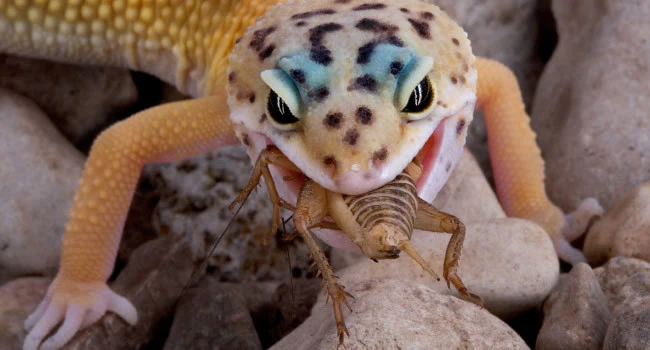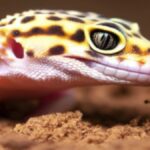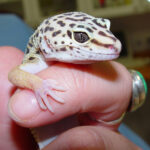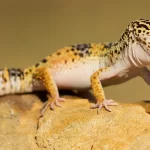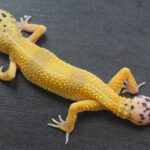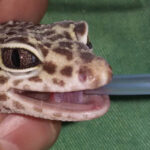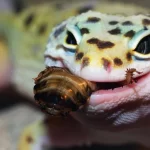Leopard geckos need to eat insects to survive. The correct principles and foods can make feeding time a pleasure for both the owner and pet Leopard geckos.
Introduction to feeding pet Leopard geckos
Leopard geckos are considered entirely insectivorous(32)(49)(50), meaning they mainly eat and digest insects as food. Popular feeder insects for healthy Leopard geckos include correctly sized crickets(30)(32)(50) and mealworms(30)(50). Popular feeding times are during the evenings, dusk and dawn. The diet of Leopard geckos needs to be supplemented with vitamins and minerals.
A variety of gut-loaded insect prey should be offered(32).
Various feeding related items for Leopard geckos and other lizards are commercially available from places like Amazon.com, pet shops, reptile retailers and other online shops.
What wild Leopard geckos eat
Living in harch, dry semi-arid areas of the world, wild Leopard geckos are known to be very adaptable. In nature, Leopard geckos are known to eat scorpions, centipedes, spiders, and beetles(71).
Also see
Natural distribution of Leopard geckos
Feeder insects for pet Leopard geckos
Because of their quality, acceptability, size and availability, crickets and mealworms will often be the most commonly used feeder insects for Leopard geckos. It is important to offer a variety of insect sizes/ages and types. Commercially available insects should take preference over, more dangerous, wild-caught ones and it is preferable that they are obtained from trusted, reputable pet shops and/or insect farms.
Although some Leopard geckos will occasionally accept dead insects, feeder insects should be alive and fresh (i.e. gut-loaded). Commercial insects can either be obtained as needed or can be bred in large or small quantities at home. Some insects such as mealworms are easy to store for longer periods, but Leopard gecko keepers typically buy enough feeder insects to last for about a week.
Other good commercial feeder insects include walking insects such as Dubia roaches(30)(50), small locusts/grasshoppers(30)(50)(71) and springtails(71) and crawling insects like waxworms(30)(50)(71), Phoenix worms, silkworms(30) and Trevo worms. The occasional pinky or nestling mouse can also be offered to adult Leopard geckos(30)(71).
Also see
Feeding crickets to Leopard geckos
Feeding mealworms to Leopard geckos
Feeding silkworms to Leopard geckos
Food sizes for Leopard geckos
Whatever feeder insects are used, they should also be the correct size for Leopard geckos. The average size of the insects that are being fed to Leopard geckos should not exceed the width of the Leopard gecko’s head. In other words, the length between the eyes of the Leopard gecko.
Feeder insects and pinky mice can often be ordered and bought according to their size. Although dependant on the type of insect, sizes are generally marked as (extra small), small, medium and large. Baby Leopard geckos will need small to medium-sized insects where adults will need larger sizes.
The number of insects that will be consumed per feeding will depend on the feeding frequency, type and size of insects, availability of ad-lib food, environmental factors such as average heating, and the age, size of the personal preference of the Leopard gecko. Depending on these factors, anything between one and around ten insects can be considered normal.
Walking insects such as crickets can be offered one-by-one, or a few at a time until the Leopard gecko has lost interest. Some keepers prefer leaving walking insects in the enclosure for up to an hour. Excess (non-eaten) insects should be removed. Free-roaming insects become ‘stale’, can spread diseases, cause stress and possibly cause injuries to sleeping Leopard geckos.
Also see
Tail injuries in Leopard geckos
Crawling insects such as mealworms can be offered ad libitum (always available) in a small shallow escape-proof dish. Although ‘crawlies’ should always be available, they must always be fresh. It is also a good idea to offer crawling insects in the same container as the powdered supplements are offered in (see below).
How often to feed Leopard geckos
The frequency of feeding depends on the age, reproductive status, body condition and health status of Leopard geckos.
It is generally accepted that baby and juvenile Leopard geckos should be fed every day until they are about 1 year of age. So should sick, pregnant females, debilitated and tailless Leopard geckos.
Depending on their body condition score, adult Leopard geckos can be fed every other day.
Supplementation for Leopard geckos
Probably the only disadvantage of feeding commercial feeder insects (vs. wild-caught insects) is that vitamin and mineral supplementation is required(50). For Leopard geckos, food supplementation is vital(30)(32).
Because it is not always advisable to supply ultraviolet (UV) lighting to Leopard geckos(30)(32), calcium and vitamin D3 supplementation plays an important role in maintaining bone mass and overall health.
Lick supplementation is part of feeding Leopard geckos. In this image, a Leopard gecko is eating mealworms from a shallow dish also containing a powdered calcium/vitamin D3 supplement. Image by Renier Delport
Feeder insects should be gut-loaded with an appropriate mineral/vitamin supplement and should be dusted two to three times a week with a calcium/vitamin D3 combination powder. An ad-lib supply of powdered calcium/vitamin D3 supplement as ‘lick’, should be supplied in a small shallow dish or lid for additional calcium needs.
Also see
Leopard gecko supplementation through gut-loading
Leopard gecko supplementation through food ‘dusting’
Supplying light to Leopard geckos
Where to feed
The best place to feed Leopard geckos is inside their enclosure — there where the temperature and lighting are more natural and preferable. To prevent accidental ingestion of particulate substrates, such as sand and gravel, food can be offered in shallow containers, on a feeding platform or, if it is tolerated, by hand.
It’s feeding time!
Being crepuscular(50)(51)(59) to nocturnal(49)(69) and cathemeral, Leopard geckos will mostly come out to feed during dusk, dawn and the evenings. This makes early mornings and the evenings the best time to offer food to Leopard geckos.
Conclusion
Correct feeding will ensure that Leopard geckos grow strong and healthy. When using the correct food and principles, feeding Leopard geckos becomes less of a chore and more of a pleasure.

